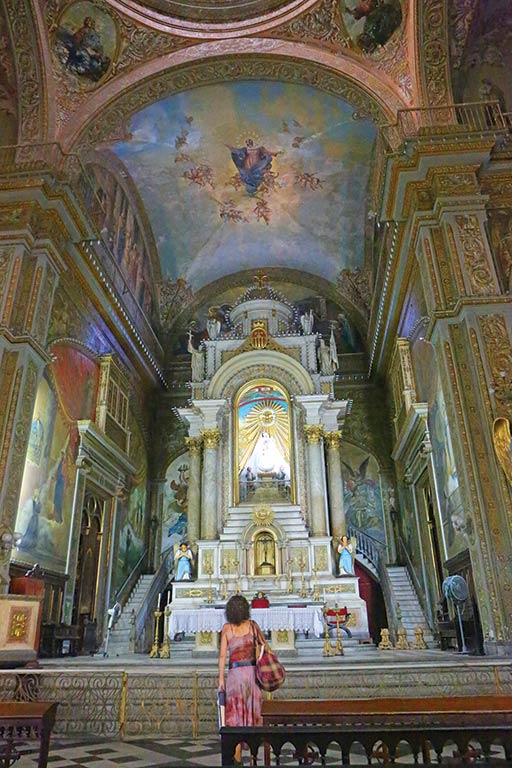The mostly residential and dilapidated southern half of Habana Vieja, south of Calle Brasil, was the ecclesiastical center of Havana during the colonial era and is studded with churches and convents. This was also Havana’s Jewish quarter.

View inside Iglesias Nuestra Senora de la Merced. Photo © Christopher P. Baker.
The Jesuits were the nation’s official weather forecasters and in 1858 erected the Observatorio Real (Royal Observatory) atop the tower.Southern Habana Vieja is enclosed by Avenida del Puerto, which swings along the harborfront and becomes Avenida San Pedro, then Avenida Leonor Pérez, then Avenida Desamparados as it curves around to Avenida de Bélgica (colloquially called Egido). The waterfront boulevard is overshadowed by warehouses. Here were the old P&O docks where the ships from Miami and Key West used to dock and where Pan American World Airways had its terminal when it was still flying the old clipper flying-boats.The handsome Iglesia y Convento de Santa Teresa de Jesús (Brasil, esq. Compostela, tel. 07/861-1445), two blocks east of Plaza del Cristo, was built by the Carmelites in 1705. The church is still in use, although the convent ceased to operate as such in 1929, when the nuns were moved out and the building was converted into a series of homes.
Across the road is the Drogería Sarrá (Brasil, e/ Compostela y Habana, tel. 07/866-7554, daily 9am-5pm, free), a fascinating apothecary—now the Museo de la Farmacia Habanera—with paneled cabinets still stocked with herbs and pharmaceuticals in colorful old bottles and ceramic jars.
The Iglesia y Convento de Nuestra Señora de Belén (Church and Convent of Our Lady of Bethlehem, Compostela y Luz, tel. 07/860-3150, Mon.-Sat. 10am-4pm, Sun. 9am-1pm, free; visits only with a pre-arranged guide with Agencia San Cristóbal), the city’s largest religious complex, occupies an entire block. The convent, completed in 1718, was built to house the first nuns to arrive in Havana and later served as a refuge for convalescents. In 1842, Spanish authorities ejected the religious order and turned the church into a government office before making it over to the Jesuits. They in turn established a college for the sons of the aristocracy. The Jesuits were the nation’s official weather forecasters and in 1858 erected the Observatorio Real (Royal Observatory) atop the tower. It was in use until 1925. The church and convent are linked to contiguous buildings across the street by an arched walkway—the Arco de Belén (Arch of Bethlehem)—spanning Acosta.
The Iglesia y Convento de Santa Clara de Asís (Convent of Saint Clair of Assisi, Cuba #610, e/ Luz y Sol, tel. 07/866-9327, closed for restoration at last visit), two blocks east of Belén, is a massive former nunnery completed in 1644. The nuns moved out in 1922. It is a remarkable building, with a lobby full of beautiful period pieces. The cloistered courtyard is surrounded by columns. Note the 17th-century fountain of a Samaritan woman, and the beautiful cloister roof carved with geometric designs—a classic alfarje—in the Salón Plenario, a marble-floored hall of imposing stature. Wooden carvings abound. The second cloister contains the so-called Sailor’s House, built by a wealthy ship owner for his daughter, whom he failed to dissuade from a life of asceticism.
The Iglesia Parroquial del Espíritu Santo (Parish Church of the Holy Ghost, Acosta #161, esq. Cuba, tel. 07/862-3410, Mon.-Fri. 8:30am-4pm), two blocks south of Santa Clara de Asís, is Havana’s oldest church, dating from 1638 (the circa-1674 central nave and facade, as well as the circa-1720 Gothic vault, are later additions), when it was a hermitage for the devotions of free blacks. Later, King Charles III granted the right of asylum here to anyone hunted by the authorities, a privilege no longer bestowed.
The church’s many surprises include a gilded, carved wooden pelican in a niche in the baptistry. The sacristy, where parish archives dating back through the 17th century are preserved, boasts an enormous cupboard full of baroque silver staffs and incense holders. Catacombs to the left of the nave are held up by subterranean tree trunks. You can explore the eerie vault that runs under the chapel, with the niches still containing the odd bone. Steps lead up to the bell tower.
Iglesia y Convento de Nuestra Señora de la Merced (Our Lady of Mercy, Cuba #806, esq. Merced, tel. 07/863-8873, daily 8am-noon and 3pm-6pm) is Havana’s most impressive church, thanks to its ornate interior multiple dome paintings and walls entirely painted in early-20th-century religious frescoes. The church, begun in 1755, has strong Afro-Cuban connections (the Virgin of Mercy is also Obatalá, goddess of earth and purity), drawing devotees of Santería. Each September 24, scores of worshippers cram in for the Virgen de la Merced’s feast day. More modest celebrations are held on the 24th of every other month.
Excerpted from the First Edition of Moon Havana.